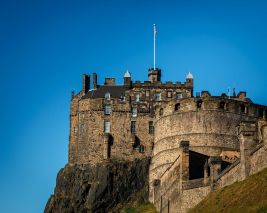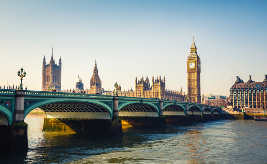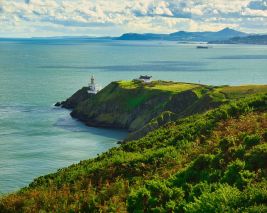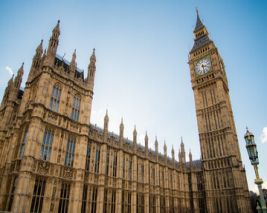Scenic Beauty, Great Food, and a Vibrant Pub Culture at the Emerald Isles
Ireland is arguably one of the best destinations in the world for travelers who want to fully immerse themselves in nature and culture. Ireland has established itself as somewhat of a cultural hub, with fantastic music and literature churned out of this country regularly. As a result, travelers can find myriad options for plays, concerts, art experiences, and of course, hiking and exposure to stunning landscapes, ancient ruins, and lovely folklore.
If you long to gaze out into an open valley, with nothing but the wind howling in your ear, a bag on your shoulders and adventure on the horizon, then plan a trip to Ireland.
| Ireland Tourism : A Quick Overview |
| Continent |
Europe |
| Capital |
Dublin |
| Official Language |
Irish, English |
| Dial Code |
+353, +44 |
| Population |
4,857,000 |
| Currency |
Euro |
| Time Zone |
UTC and UTC + 1 |
| Area |
84,421km² |
Highlights Of Ireland:
Ireland, or the ‘Emerald Isle’ is a land of mesmerising landscapes. Rolling hills and beautiful weather are the signature of this European gem. Here are some highlights of Ireland tourism:
- The Cliffs of Moher is one of the major attractions of Ireland tourism according to Ireland travel guides. The dramatic cliffs rise over 700 feet above the Atlantic Ocean and offer breathtaking views.
- Giant’s Causeway is a UNESCO World Heritage site and the pride and joy of Ireland tour guides. It's a natural wonder that features around 40,000 interlocking basalt columns found by ancient volcanic activity.
- Dublin's cultural scene Is another major highlight of Ireland tourism. From major attractions such as the Guinness Storehouse, Trinity College's Long Room Library and a lively arts and music environment, it is highly rated by Ireland travel guides.
- Ring of Kerry showcases the lush landscapes and charming villages around the historical sites of the Iveragh Peninsula. It is a popular attraction displayed proudly by Ireland tour guides.
- Killarney National Park is home to native Oakwood's majestic waterfalls and serene lakes of Killarney. It is one of the places to visit Ireland that you can’t miss.
Now, let’s explore these highlights of Ireland tourism in more detail.
Cities Of Ireland:
Dublin, the capital of Ireland, is a great place to start your journey. With all the trappings of a huge city, you’ll be able to experience fantastic nightlife, great food, and concerts. Don’t forget to chug down a glass of dark Guinness beer – something that you’ve simply got to do when in Dublin as its where this beer comes from.
Galway is another city to add to your itinerary, especially if you want to go to local pubs and enjoy live Irish music. The art galleries, busy cafes, and quaint boutiques make this city a great spot for travelers looking for fun souvenirs.
Kilkenny is a medieval city that you simply must visit just to look at the architecture and the way it creates a contrast with the stunning landscape. The Black Abbey, Cathedral Church of St Canice & Round Tower, and Rothe House and Garden are a few places you should definitely check out when in Kilkenny.
Tourist spots In Ireland:
If you’re a fan of Game of Thrones, then there’s no way that you can miss out of visiting the Causeway Coast. The Giant’s Causeway, which is a UNESCO World Heritage Site, is a collection of beautifully formed rocks and is one of the most stunning locations that you can visit in Ireland. Cross the Carrick-a-Rede bridge for a thrilling experience and then take a relaxing stroll across the 16.5-kilometer coastline to get to the Ballintoy Harbour – or the Iron Islands as Game of Thrones fans would call it.
The Ring of Kerry is a spectacular circuit that spans 179 km and takes you through mountains, medieval ruins, loughs and pristine beaches. You can also take a walk down the smaller Skellig Ring, which is a path that spins off the top of the main loop. While you’re making your way across the Ring of Kerry, take a few minutes to stop by Kenmare, Valentia Island, Waterville, Sneem, and Caherdaniel.
Connemara, which basically means Inlets of the Sea, is a stunning stretch filled with lonely valleys, the glittering sea, hidden beaches and even dramatic scenery. The beautiful roads take you from one village to another, and you’ll be able to explore quaint villages and spend relaxing evenings at local pubs where you can enjoy steaming hot clam chowder and fresh sea food! You should definitely add Clifden, Oughterard, Inishbofen, Killary Harbour, and Roudstone to your itinerary.
The Carrowkeel Megalithic Cemetery is a stunning and eerie location that’s ideal for taking some of the most breathtaking pictures that you’ll ever take in your life. With stunning tombs, stone circles, and dolmens, this place is a one of a kind spot, and boasts of being the largest cemetery in Europe. Additionally, it’s also home to the oldest Stone Age monument in Ireland. Interestingly, archeologists are still discovering ancient monuments and relics, and that’s what makes this such a great place to visit. You’ll find yourself feeling so connected to history, and this is an experience that one rarely gets to enjoy.
The Hills of Tara functioned as the seat of power in Ireland, but that’s not the only reason why you should visit this place! Walk through the Mound of Hostages, which dates all the way back to 25,000 BC and is one of the oldest monuments in the area. Marvel at the Ancient Standing Stones and get lost in the wonderful landscape of the area, wondering how nature could possibly be so beautiful.
Food in Ireland:
The food you eat really impacts your trip significantly, which is why it’s important to know about the local foods to watch out for. Soda bread, which is one of the biggest staples in Ireland, is something you’re going to come across almost every restaurant or café. Irish stew, a hearty meal filled with potatoes, carrots, and meat, is another dish that you simply must try.
Sea food lovers should travel to Ireland in September so that they can be a part of the Galway Oyster Festival. Boxty, another great dish, is made of potato pancakes, potato breads, dumplings and crispy bacon. You can even try this dish with some delicious smoked salmon and crème fraiche.
For travelers that are a bit more adventurous with their palate, black pudding is a dish you must try. It’s made of fat, blood, and pork meat along with suet, barley and oatmeal. If the idea of blood makes you squeamish though, you can always try white pudding instead – it’s the same thing without the blood!
Of course, it goes without saying that Ireland is the place for beer, since it’s the birthplace of Guinness. Fermented milk is another popular drink that you should try at least once, and the same goes for Irish whiskey.
Interesting facts about Ireland:
- The titanic was built in Northern Ireland and you can visit museums dedicated to the legendary ship.
- As of 2009, it is illegal to be drunk in public in this country! You can drink in bars and pubs as long as you maintain your composure.
- When it comes to the amount of beer drunk per person, Ireland ranks the 6th in the world! In fact, on average, an Irish person drinks at least 100 liters of beer in a year.
- The factories in Dublin produce over 10 million pints of Guinness daily!
- The Cliffs of Mohair are shown in Harry Potter and the Half Blood Prince – it’s where Tom Riddle hid his Horcrux.
- Fairies and leprechauns are part of the Irish folklore. People believe that these magical creatures are responsible for all the good luck you may receive in your life.
- The average Irish person drinks over 1184 cups of tea every year.
- The oldest bar in Ireland is Sean’s Bar. It’s over 900 years old!
Location Of Ireland:
Ireland is a country situated in northwestern Europe. It occupies most of the island on the West side of Great Britain and is separated by the Irish Sea. According to Ireland Travel Guides, the country shares its borders to the north with Northern Ireland, which is part of the United Kingdom. It is surrounded on all other sides by the Atlantic Ocean.
The strategic location of the country serves to make Ireland a bridge between North America and mainland Europe. Determining how to reach Ireland from different parts of the world is relatively easier due to its proximity to vast waterways. It also features roadways and Airways travel from around the world, making it simpler to find the means of how to reach Ireland from your country.
Best time to visit Ireland:
Irish weather is notoriously unpredictable, which is why the best time to visit Ireland doesn’t not normally depend on the weather conditions. In fact, it’s not unheard of to experience all four seasons in the same day.
The summer season (July and August in particular) is the peak season of travel and you’ll run into lots of tourists at this time. This is when you’ll also find high tariffs and fewer accommodation options (unless you book your room way before you travel to the country). The shoulder season, which occurs during April – June as well as September to October, is the ideal time to visit as there will be fewer tourists. The best part about this season is that things are still quite perky, unlike the winter season when most people begin to shut shop and head hope earlier.
Travelling to Ireland in the winter season means dealing with the bitter cold, but all this can be worth it for the sheer joy for spending Christmas in Dublin. The festivities in the air and hospitality of the Dubliners will definitely make you forget about the cold weather and focus more on the stunning beauty of this country instead.
Spring sets into Ireland from March to May. It is the best time to visit Ireland as the countryside awakens with vibrant blooms. The days are lengthier, much like summer, but it is the ideal time for a trip to the places to visit Ireland and other outdoor activities.
Autumn is also the best time to visit Ireland from September to November owing to the landscape of Ireland tourism changing drastically. The rich autumn hues, cultural events, and thinning crowds make it a delightful time for both nature lovers and art enthusiasts alike.
How to get to Ireland:
By Air: Ireland has four main international airports located in Dublin, Cork, Shannon and Knock. Dublin is the most connected airport of them all and even ranks as the 8th largest airport in all of Europe. You’ll be able to find flights that travel to Dublin from any of the major Indian cities quite easily. Of course, do keep in mind that unlike many other nations that are a part of the EU, Ireland is not a part of the Schengen Agreement. This means that you need to get a visa for the country even if you have a valid Schengen visa on hand.
By train: The only way to get to Ireland via train is if you’re travelling from Northern Ireland to the Republic of Ireland. As this is an island nation, you won’t find any connecting trains from other European countries! The same holds true for travelling to Ireland via road (by bus or car).
By Boat: If you’re backpacking across Europe and want to operate on a shoe string budget, then traveling to Ireland by ferry is a great idea. You’ll find boats that connect to the country from France, Great Britain and even Spain.
History Of Ireland:
Before 10,000 BC, Ireland was covered in snow. With the dawn of the Iron Age, Celtic civilization began to settle down on the island, though where these settlers came from is not clear. Though it was taken over by Great Britain for a long time, it won its independence in 1921, once the Anglo-Irish treaty was signed.
The country’s history, as recited by Ireland tour guides, is a tapestry woven with tales of ancient civilisations, medieval conquests, and a rich cultural evolution. Here are the highlights of Ireland’s history as per Ireland tourism:
- Ancient Heritage - The island’s history dates back to 6000 BCE when early inhabitants left behind remarkable structures like the Newgrange passage tomb that predates Egyptian pyramids. These are top places to visit Ireland and you can find detailed stories about them in Ireland travel guides.
- Medieval Period - Christianity was established in the 5th century, thanks to Saint Patrick. It led to the establishment of monasteries which were the center of learning and art. The Irish commemorate this on Saint Patrick’s Day, which is a major celebration in Ireland tourism.
- Viking and Norman Invasions - The Vikings set up camp around the area that is now Dublin between the 8th and 12th centuries. This was soon followed by the Nom=rman invasions that reshaped Ireland’s political landscape. It is much discussed in Ireland travel guides.
- Colonial Era and Struggle for Independence - Centuries of English rule culminated in the early 20th century. The Irish War of Independence led to the establishment of the Irish Free State in 1922.
- Modern Developments - In the late 20th and early 21st centuries, Ireland experienced significant economic growth, and cultural revival, and promoted the peace process in Northern Ireland.
There is much to learn about the country’s history in Ireland Tourism. You can refer to Ireland travel guides or talk to the locals for an immersive account of Ireland’s rich history.
Can’t wait to take strolls down the beautiful Irish landscape? Check out Thomas Cook’s travel packages and plan your holiday!

































